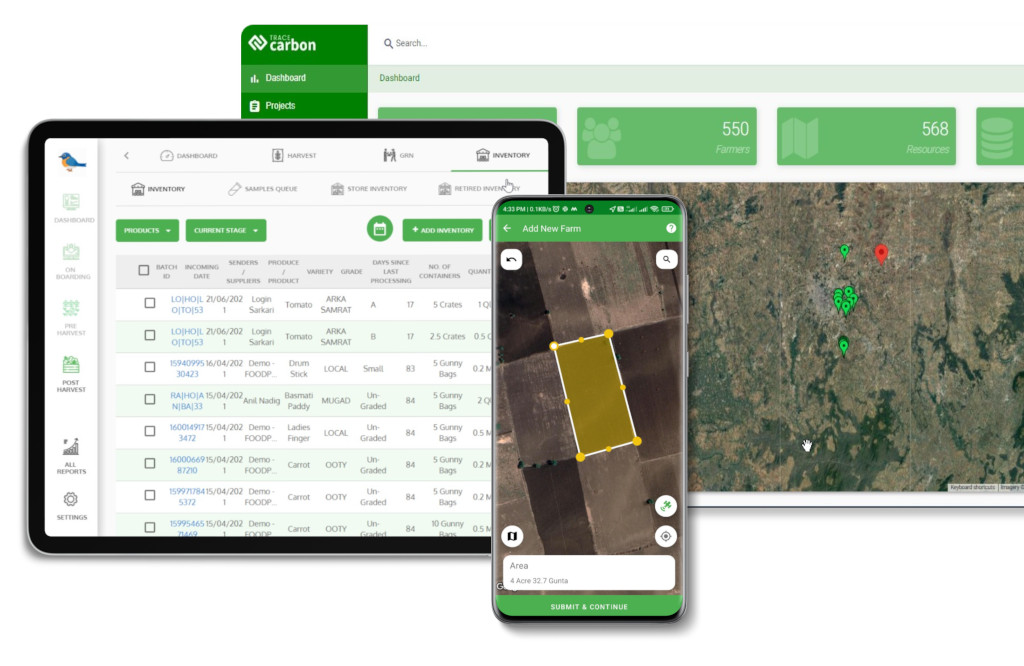Contact: +91 99725 24322 |
Menu
Menu
Quick summary: Discover what Ugandan coffee exporters, traders, and co-ops must do to comply with EUDR—from farm mapping to DDS—with zero disruption to EU access.

Uganda coffee is subject to the EU Deforestation Regulation (EUDR), which requires proof that it was not grown on deforested land after December 31, 2020.
Exporters and traders must provide geolocation data, verify land legality, and submit a Due Diligence Statement (DDS) to access the EU market.
Digital traceability tools are essential to help Uganda coffee supply chains comply efficiently.
Much of Uganda’s coffee comes from smallholder farmers and cooperatives with limited digital infrastructure, informal land records, and paper-based systems. Without rapid digitization and supply chain coordination, even compliant growers risk being left behind.
But there’s a solution: digital traceability tools that simplify EUDR compliance by helping you map farms, validate supplier data, and auto-generate DDS reports—at scale and without the paperwork chaos.
Key Takeaways
Uganda coffee is directly regulated under the EU Deforestation Regulation (EUDR), which requires all supply chain actors—from smallholder farmers to exporters—to prove that coffee is deforestation-free, legally sourced, and traceable to the exact farm plot. Non-compliance risks include shipment rejection, trade disruption, and exclusion from the EU market. To comply, actors must collect GPS-based geolocation polygons, verify land and labor legality, digitize farmer profiles, ensure end-to-end traceability, and generate Due Diligence Statements (DDS). TraceX simplifies this complex process with mobile-first farm mapping, automated DDS generation, real-time compliance alerts, and blockchain-backed traceability—empowering Uganda stakeholders to meet EUDR standards while protecting livelihoods and access to the EU coffee market.
Uganda’s coffee trade with the EU is both large and strategically significant, making EUDR compliance critical:
This classification puts Uganda in a more demanding compliance category compared to “low-risk” nations, making digital traceability and documentation non-negotiable for EU access.

EUDR isn’t a barrier; it’s a brand accelerator. Uganda exporters who digitize first can command price premiums from EU roasters desperate for compliant, single-origin beans. Think of traceability as a “digital terroir”—it not only answers the regulator’s questions but also gives specialty buyers a story they can sell on the shelf.
By moving fast on geolocation and legality proof, Uganda can transform compliance pressure into a value-added narrative: climate-smart, smallholder-empowered, and deforestation-free coffee that stands out in an increasingly regulated marketplace.
Want to understand how EUDR impacts Uganda’s coffee exports and what risk classification means for your business?
Read Now:
Under the EUDR, responsibility flows with the product. Any entity that touches Uganda coffee before it reaches an EU shelf must either file—or be able to prove—the due-diligence behind every bean.
These are the first actors placing coffee on the EU market. They must:
“When I’m an exporter, I need a tool that digitises farmer data and auto-builds a DDS so my container clears customs the first time.”
Traceability feature match: mobile polygon capture, bulk document upload, one-click DDS generator.
While traders can rely on the upstream DDS, blind trust is a gamble. They must:
“When I’m a roaster, I need instant visibility into supplier risk so I don’t roast beans that will be pulled from shelves later.”
Traceability feature match: shared dashboards, supplier risk scores, expiry alerts.
Risks of Non-Compliance
Uganda: A “Standard-Risk” Origin
The EU’s country benchmarking has listed Uganda as standard risk. That means European customs will expect full due diligence on every lot, not the lighter “simplified” route.
Standard risk isn’t a disadvantage; it’s an invitation for Uganda exporters to out-perform competitors by getting digital first. Those who master traceability now will own shelf space when enforcement tightens.
For every farmer or cooperative contributing to a coffee lot, you must collect precise geolocation data—not just the district or region, but the actual GPS polygons that mark the farm boundaries.
You must demonstrate that coffee was grown on legally acquired land and that labor practices follow national laws and international standards.
Traceability starts with knowing who is producing the coffee, where, and under what conditions. This means building detailed digital profiles for every producer, cooperative, and aggregator.
EUDR doesn’t stop at the farm. You must show how the beans move from farm to warehouse to export—without mixing or losing identity.
The DDS is your official declaration that every product entering the EU market is deforestation-free and legally produced. This is the core compliance document required under EUDR.
Those who digitize their supplier network now will not only meet EUDR standards—they’ll win faster buyer trust, better prices, and long-term market access.
If you’re in the business of Uganda coffee, these five actions aren’t optional—they’re the foundation of a resilient, future-ready supply chain.
Uganda’s coffee sector is facing a regulatory turning point. With the EU Deforestation Regulation (EUDR) in effect, exporters, cooperatives, and buyers can no longer rely on paper-based sourcing logs or informal land records. Digital traceability is no longer a bonus—it’s the backbone of EUDR compliance.
Here’s how digital traceability tools—like TraceX—help Uganda’s coffee supply chain meet the regulation’s demands efficiently, accurately, and at scale. TraceX steps in as a digital backbone that connects farmers, cooperatives, exporters, and international buyers with the tools they need to meet these new standards—seamlessly and at scale.
The EUDR requires that every lot of coffee be traceable back to the exact piece of land it was grown on.
See how digital farm mapping is helping Nigerian cocoa exporters meet EUDR and sustainability goals—while building trust with buyers.
EUDR isn’t just about location—it’s about proof. Exporters must show that coffee is grown on legal land and under compliant labor conditions.
In a complex sourcing network a Nigerian trading company manages cocoa procurement from 5,000–8,000 farmers through a layered hierarchy of field agents, data supervisors, LBAs, and main stores — maintaining data accuracy, security, and operational efficiency is extremely challenging. That’s where a Role-Based Access Control (RBAC) feature becomes essential.
RBAC is a digital traceability feature that assigns permissions and platform access based on a user’s role in the supply chain. Instead of giving everyone access to all information, users only see and act on data relevant to their responsibilities.
Filing the Due Diligence Statement (DDS) is one of the most critical steps in EUDR compliance—and also one of the most prone to human error.

The EUDR requires you to retain records for five years and show a clean audit trail from the moment a cherry is harvested to the point the green beans enter the EU.

TraceX enables multi-party collaboration through shared dashboards and access-controlled workflows.
Exporters, aggregators, processors, and EU-based traders can all interact with the same source of data—no email threads, no version chaos.
EUDR compliance isn’t optional—it’s the new baseline for access to the EU coffee market. For Uganda, where millions depend on smallholder coffee exports, failing to prepare could mean shipment rejections, lost income, and reputational damage. But the good news? With digital tools for farm mapping, legality checks, and DDS generation, producers, aggregators, and exporters can achieve compliance faster and with more confidence. Don’t wait for audits or bottlenecks—start building a traceable, deforestation-free coffee supply chain today.
Yes. Coffee is a regulated commodity, and Uganda exports to the EU must be deforestation-free and legally sourced with verified geolocation data.
Operators must provide geolocation polygons, land legality proof, and a Due Diligence Statement (DDS) before placing coffee on the EU market.
Absolutely. With digital mapping, cooperative support, and traceability tools, smallholder producers can meet all EUDR requirements effectively.
Looking to master every step of the EUDR journey—from onboarding smallholder suppliers to filing Due Diligence Statements (DDS)?
EUDR Due Diligence: What You Need to Know
How to File a DDS for EUDR Compliance
